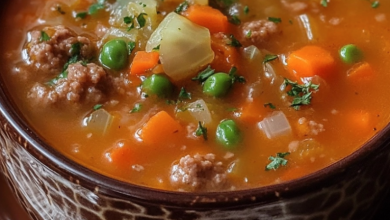Unlocking the Secrets of Hot and Sour Soup: A Culinary Adventure

More Than Just a Soup
There are few dishes in the world that can simultaneously wake up your senses, soothe your soul, and clear your sinuses. Hot and Sour Soup, a cornerstone of Sino-American cuisine, is one such powerhouse. At first glance, it might seem like a simple, murky broth. But with one spoonful, you’re transported. Your taste buds are greeted by a complex symphony: the fiery kick of white pepper, the tangy punch of vinegar, the savory depth of the broth, and a textural playground of tender mushrooms, crunchy bamboo, and silky ribbons of egg.
This article is your definitive guide. We’ll journey through its fascinating history, break down its core components, and provide you with an exclusive, restaurant-quality recipe that will demystify this beloved soup forever.
A Brief History: From Royal Courts to Global Kitchens
The origins of Hot and Sour Soup are as complex as its flavor profile. It is believed to have originated in Northern China, with two primary regional variations:
- The Sichuan Version: This is the version most Westerners are familiar with. Hailing from the Sichuan province, famous for its bold, “mala” (numbing and spicy) flavors, this soup gets its heat primarily from white pepper. It’s a hearty, thick soup packed with ingredients like wood ear mushrooms, bamboo shoots, and tofu.
- The Guizhou Version: From the Guizhou province, this version tends to be clearer and derives its signature tang from a fermented rice vinegar, offering a different, yet equally captivating, sour note.
The soup gained immense popularity in the United States throughout the 20th century, becoming a staple on virtually every Chinese restaurant menu. Its ability to comfort and invigorate made it an instant classic. Today, it’s not just a restaurant dish but a celebrated homemade meal for those in the know.
The “Hot” and the “Sour”: Understanding the Core Flavors
The magic of this soup lies in the perfect equilibrium between its two namesake sensations.
- The “Hot” : Contrary to popular belief, the primary heat source is not chili powder or chili oil (though these can be additions), but ground white pepper. White pepper provides a sharp, penetrating, and clean heat that builds with each sip. It warms you from the inside out without overpowering the other ingredients. For an extra kick, a drizzle of chili oil at the end is always an option.
- The “Sour”: The tanginess is achieved through a careful balance of vinegars. Most recipes use Chinese black vinegar for its deep, smoky, and slightly sweet complexity, often complemented by the sharper, more straightforward acidity of rice vinegar. The vinegar is typically added in two stages once during cooking and once at the end to build a layered sourness.
Health Benefits: A Bowl of Wellness
Hot and Sour Soup isn’t just delicious; it’s incredibly good for you. It’s a low-calorie, nutrient-dense dish with several health advantages:
- Immunity Booster: The combination of garlic, ginger, and mushrooms (like shiitake) is packed with antioxidants and compounds that support the immune system.
- Clears Sinuses: The steam and the spiciness from the white pepper are excellent for breaking up congestion, making it a perfect comfort food when you have a cold.
- Digestive Aid: Ginger is a well-known digestive aid that can help soothe an upset stomach, while vinegar can promote healthy gut bacteria.
- Anti-Inflammatory: Many of its ingredients, including ginger and mushrooms, have natural anti-inflammatory properties.
Exclusive Homemade Hot and Sour Soup Recipe
Forget the bland, gloopy versions you might have had. This recipe focuses on creating a beautifully balanced, complex, and texturally perfect soup.
Prep Time: 30 minutes
Cook Time: 20 minutes
Servings: 4-6
Ingredients You’ll Need:
For the Broth Base:
- 8 cups (2 liters) good-quality chicken or vegetable stock
- 4-5 slices of fresh ginger (about 1.5 inches, smashed)
- 3 cloves garlic, minced
- 2-3 tablespoons soy sauce (or to taste)
- 1 tablespoon dark soy sauce (for color – optional but recommended)
The Protein & Vegetables:
- 150g (5 oz) boneless, skinless chicken breast or pork loin, cut into very thin strips (optional, can be omitted for vegetarian)
- 100g (3.5 oz) firm tofu, cut into small, thin strips
- 4-5 dried shiitake mushrooms, rehydrated and sliced (keep the soaking liquid!)
- 50g (1.7 oz) canned bamboo shoots, julienned
- 25g (0.9 oz) dried wood ear fungus, rehydrated and sliced
- 50g (1.7 oz) canned sliced water chestnuts (for extra crunch)
The “Hot and Sour” Elements:
- 2-3 teaspoons freshly ground white pepper (adjust to your heat preference)
- 4-5 tablespoons Chinese black vinegar
- 1-2 tablespoons rice vinegar
The Thickening & Finish:
- 4 tablespoons cornstarch mixed with 5 tablespoons cold water (slurry)
- 2 large eggs, lightly beaten
- 2-3 green onions, finely chopped
- 1 teaspoon sesame oil
- Chili oil for serving (optional)
Step-by-Step Cooking Method:
(Image Suggestion: A step-by-step collage showing the key stages: rehydrating mushrooms, making the slurry, drizzling the egg.)
Step 1: Prepare and Rehydrate
Start by rehydrating the dried shiitake mushrooms and wood ear fungus. Place them in separate bowls and cover with hot water. Let them soak for 20-30 minutes until soft and pliable. Once soft, slice them thinly. Reserve the mushroom soaking liquid – it’s packed with umami flavor. Strain it through a fine-mesh sieve or cheesecloth to remove any grit.
Step 2: Build the Flavor Foundation
In a large pot, bring the chicken/vegetable stock to a simmer. Add the smashed ginger slices, minced garlic, soy sauces, and the reserved mushroom soaking liquid. Let this simmer gently for about 10 minutes to allow the flavors to meld. Then, use a slotted spoon to remove and discard the ginger slices.
Step 3: Cook the Main Ingredients
Add the sliced shiitake mushrooms, wood ear fungus, bamboo shoots, and water chestnuts to the simmering broth. If you are using chicken or pork, add the thin strips now as well. Let it cook for 5-7 minutes until the meat is cooked through and the vegetables are tender.
Step 4: Incorporate Tofu and Season
Gently stir in the strips of tofu. Now, it’s time for the star players: add the ground white pepper and the Chinese black vinegar. Start with the lower amounts, taste the soup, and adjust. Remember, you can always add more, but you can’t take it out!
Step 5: Thicken the Soup
Give the cornstarch slurry a quick stir (as it separates) and slowly pour it into the simmering soup while stirring constantly. The soup will thicken almost immediately. Let it simmer for another minute until it reaches a velvety, gravy-like consistency. If it’s too thick, add a bit more stock or water.
Step 6: The Signature Egg Ribbons
This step requires a gentle hand. Turn the heat down to low so the soup is no longer at a rolling boil. Using a fork or chopsticks, slowly drizzle the beaten eggs in a thin, steady stream over the surface of the soup. Let the eggs sit for 10-15 seconds without stirring to set, then gently swirl the pot or stir slowly to create those beautiful, silky ribbons.
Step 7: The Final Touches
Turn off the heat. Stir in the final, crucial flavor enhancers: the sesame oil and the chopped green onions. For an extra layer of sourness, you can add an additional tablespoon of rice vinegar at this stage.
Serving and Pro-Tips for Perfection
- Serve Immediately: Hot and Sour Soup is best enjoyed fresh and piping hot.
- Garnish: Serve with a sprinkle of extra green onions and a drizzle of chili oil on the side for those who desire more heat.
- Pro-Tip 1: Do not boil the soup after adding the vinegar for the final time, as high heat can cause it to lose its sharp, aromatic tang.
- Pro-Tip 2: The key to perfect egg ribbons is a calm, non-boiling soup when you add the egg and patience before stirring.
- Make it Your Own: Feel free to add other ingredients like lily buds, tiger lily stems, or even a small amount of corn for a touch of sweetness.
Conclusion: Your New Culinary Staple
Mastering Hot and Sour Soup at home is a rewarding culinary achievement. It allows you to control the quality of ingredients and tailor the “hot” and “sour” levels to your exact preference. This isn’t just a recipe; it’s a passport to creating a restaurant-quality classic in your own kitchen. So, gather your ingredients, embrace the process, and get ready to enjoy one of the most vibrant and comforting bowls of soup you’ll ever taste.



